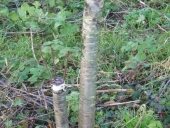



















I can't answer many of your questions, but if you're only wanting 4 trees why not just buy them outright?
I'm zone 6a and although the winter (which was colder than average) killed most of the above ground tree it's sprouting up from the ground at the base. Waiting to see how it pans out as it hasn't had a full grow season yet, but thus far seems to be doing well given the set back.











R Ranson wrote:Good question. Locally they start at $75 a tree, and go well beyond $200 for a adequate size one for my needs, it's well beyond my budget to buy them all. Also, I have a 1/4 acre pasture that I'm thinking of filling with almond trees in a year or two.... so minimum 4 trees, more likely 40. The other problem with buying trees is that I don't know the quality I'm getting. I don't know what conditions these trees are use to, but I suspect they are cultivated to thrive in high quality potting soil with high inputs of water, chemical fertilizer and pesticides. My growing conditions are quite different, as we are still in the process of building our soil. When I grow my own trees from seed, I allow natural selection to have a heavy hand in the process. If it can survive our soil, 6 months of drought, nothing but organic inputs, then I know when I plant it out in the final location, that it is very likely to thrive... the babies commercial trees... they almost always die on me. If this style works with fruit trees, it might just work with almonds.








Alder Burns wrote: ... Almond will graft onto peach, and possibly other stone fruits, and in fact such trees may be more tolerant to wet conditions than on almond roots. Almond is naturally a semi-arid or Mediterranean tree and despises poor drainage, especially in the growing season. And they do benefit from a pollinator.
The biggest problem with almonds (and to some extent, apricots as well) in most of North America is that they bloom at the first hint of spring, and invariably the bloom or young fruit get hit with a late frost. There are a few varieties that are later blooming, and planting the trees where they are shaded in the winter (but sunny in the growing season....an interesting design challenge!) might help. But if you are along the west coast, that might not be so much of a problem. Peaches, at least, are subject to peach leaf curl anywhere much north of me, so that's something to watch out for too....(peaches and almonds are actually very closely related)















I think that grafting is more common (and easier to do yourself) with all of these than budding.















R Ranson wrote:
Almonds start producing nuts at about five years old, and really get into the swing of things at about 10 years. One single, healthy and happy tree, can produce 30 to 50 pounds of nuts per year! For 50 years! That's... let's see... 1500 to 25 hundred pounds of nuts for the life of one tree. Depending on where in the world you are, that's about one tonne! At that rate, I only need four trees to keep me happy.
R Ranson wrote:
I know we can grow them from seed, so long as the nut is fresh and untreated. There are a few tricks like carefully shelling them and making them feel like they had a proper winter. We could even use grocery store almonds, apparently. Can anyone tell us what we are looking for when buying almonds for seeds?
They want the same growing conditions as peaches, since they are the same species. They need some winter chill, but not much. You'll be successful with almonds anywhere within the zone 7-9 climate types.R Ranson wrote:
What growing conditions do almonds want? Are there different kinds of almonds suited to different parts of the world? Do almonds need a friend to exchange pollan with or are they self fertile? If they need a friend, can that friend be a clone - or are there defences that prevent incestual nut procration?
Some varieties are self-fertile, but some prefer cross-pollination. If you want four trees, get four varieties. You can find anything you want mail-order.R Ranson wrote:
Do almonds need a friend to exchange pollan with or are they self fertile? If they need a friend, can that friend be a clone - or are there defences that prevent incestual nut procration?
Can't say definitively, but I have grafted Japanese plum onto almond rootstock, so I assume you can graft almond onto plum. Just how much plum seed do you have? I'd say the easiest route is to just buy raw almonds, plant those, and graft them the following year.R Ranson wrote:
And the most important question of all: Since I know I can bud a plum tree onto an almond rootstock, can I bud an almond onto a plum rootstock?















Living in Anjou , France,
For the many not for the few
http://www.permies.com/t/80/31583/projects/Permie-Pennies-France#330873








r ranson wrote:I've bought raw almonds from just about every grocery store in town, done a germination test and zilch! I think I know why.
Almonds for sale here come from California. For some reason, all almonds from California are irradiated. Could this be why they aren't growing?
Or, perhaps, there's a better way to do a germination test? I soaked them and kept some in the fridge and some at room temp, moist between two paper towels. They went mouldy before anything grew.












|
A timing clock, fuse wire, high explosives and a tiny ad:
The new permaculture playing cards kickstarter is now live!
https://www.kickstarter.com/projects/paulwheaton/garden-cards
|





